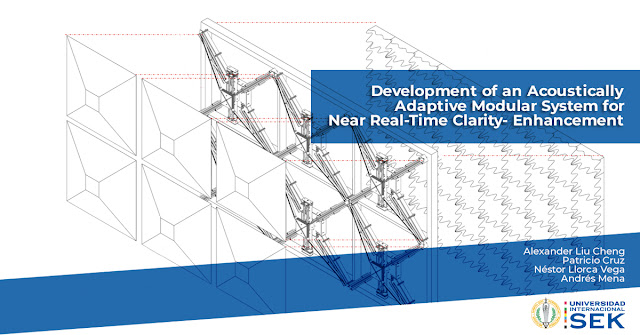Development of an Acoustically Adaptive Modular System for Near Real-Time Clarity-Enhancement
This paper details the development of an acoustically adaptive modular system capable of
enhancing Speech Clarity (C50 Clarity Index) in specific locations within a space in near real-
time. The mechanical component of the system con-sists of quadrilateral, truncated pyramidal
modules that extend or retract perpen-dicularly to their base. This enables said modules (1) to
change in the steepness of the sides of their frustum, which changes the way incoming sound
waves are deflected / reflected / diffused by the surfaces of the pyramid; and (2) to reveal or
to hide the absorbent material under each module, which enables a portion of in-coming
sound waves to be absorbed / dissipated in a controlled manner. The pre-sent setup
considers a fragmentary implementation of six modules. The behavior of these modules is
determined by two steps in the computational component of the system. First, the initial
position of the modules is set via a model previously generated by an evolutionary solver,
which identifies the optimal extension / re-traction extent of each of the six modules to select
for individual configurations that collectively ascertain the highest clarity in said specific
locations. Second, a simulated receiver at the location in question measures the actual clarity
attained and updates the model’s database with respect to the configuration’s correspond-ing
clarity-value. Since the nature of acoustics is not exact, if the attained meas-urement is lower
than the model’s prediction for said location under the best module-configuration, but higher
than the second-best configuration for the same location, the modules remain at the initial
configuration. However, if the attained values are lower, this step reconfigures the modules to
instantiate the second—or third-, fourth-, etc.—best configuration and updates the model’s
database with re-spect to the new optimal module-configuration value. These steps repeat
each time the user moves to another specific location. The objective of the system is to
contribute to the intelligent and intuitive Speech Clarity regulation of an inhabited space. This
contributes to its Interior Environmental Quality, which promotes well-being and quality of life. Read more here.
Authors:
- Alexander Liu Cheng
- Patricio Cruz
- Néstor Llorca Vega
- Andrés Mena

Comentarios
Publicar un comentario